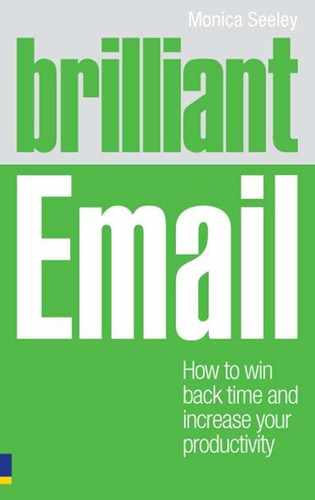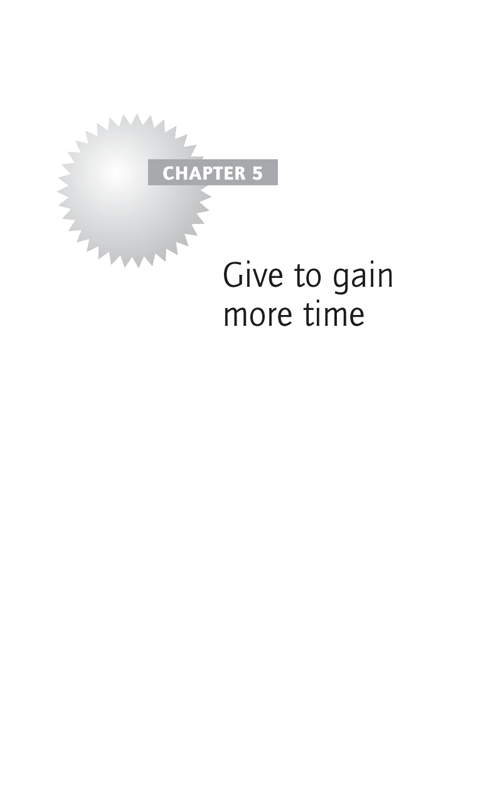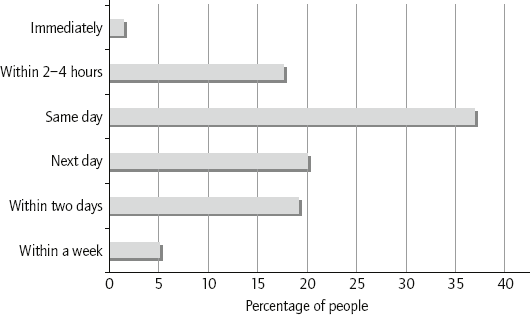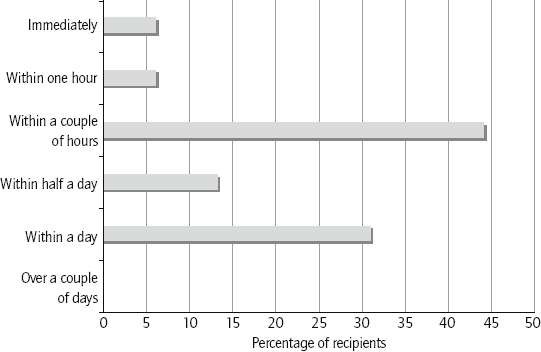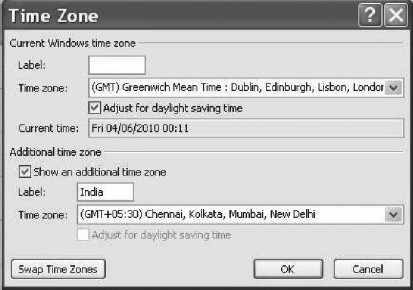Planning is an unnatural process; it is much more fun to do something. The nicest thing about not planning is that failure comes as a complete surprise, rather than being preceded by a period of worry and depression.
Sir John Harvey-Jones
This chapter covers how to be more effective by providing enough time for your email recipient. It focuses on how you can:
- improve the use of your time and that of your colleagues by making sure you leave people sufficient time to reply properly to your email
- increase the probability of meeting deadlines, even when others you depend on are unavailable
- further reduce the email stress factor
- promote even better working relationships.
How often have you rushed to complete and email a report only to have an out-of-office message ping back at you? How often do you need an urgent reply from a colleague and have the same thing happen? Both often result in wasted time, missed deadlines and increased levels of stress.
Unrealistic expectations
Email shortens the delivery time but it does not and cannot shorten the thinking time. Rarely does it even shorten the time needed to perform a task such as prepare board papers, revise a sales proposal or rehearse a presentation. Email allows us to leave things to the last minute and expect miracles. You get ‘the monkey off your back’ and onto someone else’s – usually the recipient’s.
Downsides of leaving insufficient time for the recipient
Truncated and last-minute delivery times generally only serve to drive up stress levels, wreck working relations and set unrealistic expectations. This is because we have compressed reply times and set impractical and unreasonable deadlines. Other downsides of not planning properly and expecting an immediate reply include:
- Missed deadlines – sometimes with financial repercussions (for example, failing to file a legal action, spot a tender date, miss a news story).
- Poor customer satisfaction – the ultimate recipient (customer, etc.) expects a quick reply. However, internal processes mean that the time it takes to compose a reply can be quite lengthy. This can lead to customer dissatisfaction.
- Incorrect responses – haste increases the risk of producing an inappropriate, sloppy, or even incorrect reply, with possible financial consequences.
- Security breaches – speed increases risk of security and compliance breaches from poorly worded replies.
- Damage to company image and personal reputation – all the above can create an adverse image of the company/individual.
The time you give the recipient is another aspect of your email DNA fingerprint. It creates a perception of you and the professionalism – or otherwise – of your business in the recipient’s mind. It may also suggest that the recipient was bottom of your priority list and not deserving of your full attention and planning.
The benefits of allowing sufficient time for the recipient
The productivity gains to be made from planning ahead and leaving the recipient sufficient time to make a proper reply include:
- Reduced stress levels.
- Better quality replies.
- Customer delight when you reply within the expected timeframe.
- Reduced risk of missing important deadlines.
- Improved professional image of you and your business.
- Better working relationships and an increased ‘confidence rating’ with the recipient: when you do need an urgent reply they are more likely to accommodate you, seeing it as an exception rather than your usual way of working.
What is a realistic response time?
The crux to providing time for the recipient is having a sensible baseline for what you all feel is an acceptable response time – an ‘email service level agreement’ just as you would have in many other parts of your business (helpdesk, customer service, etc.).

Half a day or within four hours is the recommended norm for expecting a reply to both internal and external emails.
Benchmarking exercise
- How quickly do you expect a reply to an email you send ?
- How quickly do you expect to reply to emails you receive?
- Ask your colleagues how quickly they think you want a reply.
- Is there a mismatch between the responses to these questions?
- If there is a mismatch, what do you think is the cause?
- What image do your expectations convey?
- Is this the right image for you (and your business)?
Mind the gap
Figure 5.1 shows the results of a survey conducted for a client. This is what senders say they expect:
All too often there is a disparity between the perceptions of the sender and recipient about what is expected. Compare this with the results in Figure 5.2 of what recipients in one organisation thought was expected of them.
Forty-four per cent felt that in reality a reply was expected within a couple of hours and nearly a third felt that to reply within a day is acceptable. When the results were presented to the management team in this organisation, they were visibly shocked at the disparity – they thought everyone understood that half a day was an acceptable response time.
Many managers in other organisations often comment that they are surprised by how quickly people respond to emails that they themselves felt were not that urgent. Equally there are those who do expect an instant reply. Journalists are often the worst in terms of expecting an instant reply. Sometimes it’s acceptable when in response to a news story. At other times it’s just because of bad planning and a deadline creeping up.
PAs often tell me that their manager expects an instant reply. Yet, when challenged about whether they have discussed what is a realistic reply time, few have even discussed this issue.
Like myself, Rob Bamforth, Principal Analyst, Quocirca (the UK research and analysis company) has observed that those with handheld mobile devices often expect a far quicker reply than those operating from a conventional laptop or PC. Part of this lies in, and is driven by, our ‘instant gratification’ society and the 7/24/365 day culture in which we live. But is it realistic and does it leave sufficient time for a considered reply?
How to establish a realistic response time
To decide what an acceptable response time is for you, consider these three factors:
- The content of the email – a reasonable response time to a request for guidance on a complex legal issue could easily be a day or two. A revised price structure might be a day.
- The nature of your business – for example, a request under the Freedom of Information Act must be responded to within 20 days.
- What is really meant by a ‘reply’? – do you mean a full answer or, at the minimum level, an acknowledgement of your email?
Before sending an email, ask yourself, how long will it take me to do this task? Now double it and that is probably a good yardstick of an acceptable response time for your business.
You can refine your baseline reply time, depending on your business, by using the following criteria and sanity checks:
- Review with your colleagues and those you work most closely with what they expect.
- Agree a baseline, and then identify exceptions and how to deal with them (such as by phone).
- Work to these guidelines for a couple of weeks and note the pros and cons.
- Revise as appropriate.
- Incorporate these response times as part of your email best practice policy, contracts, terms and agreements.
- Promote the benefits of working to sensible response times.
- Share these service level agreements (internal and external) on your website, in contracts, in your email signature.
Having a baseline for an acceptable response time often means planning ahead. For example, if you produce the monthly sales report or campaign analysis, then you must make sure that you email those providing the input at least half a day ahead. While that is not always possible, it’s fairer than always working to tight deadlines.
You might just be surprised at how well such suggestions are received. It makes working relationships much easier as everyone then knows and is working to the same standards.
Other ways to improve how you work through email
The key is not to prioritize what is on the schedule, but to schedule your priorities.
Stephen Covey
![]()
One executive works very early in the morning (around 5.00 am). However, she feels that rarely are the emails she sends so urgent that the recipient needs to respond ahead of their own priorities. To stop the recipients (often her team members) from getting distracted, she delays sending the message.
Leaving time for the respondent allows you to create the right impression. It means that both you and the recipient are operating from a level playing field and you don’t impose either your poor planning or sense of urgency on other people. There are a number of other ways you can try to do this:
- Check calendars to see who is available when and then agree a sensible timescale. This is very useful when the person you are working with travels frequently.
- Build in time – when you know your reply has to be reviewed by others, manage the sender’s expectation of when they will get a response. For example, in many law practices, replies from juniors and trainees have to be reviewed by a senior partner before being sent externally.
- Establish priorities – and if the matter is urgent and may require some time, discuss current priorities. If there is a mismatch work out how to overcome it. Don’t just send an email and expect the person to action the matter.
- Add ‘Time Zones’ when working with someone in another time zone. To add an extra time zone to your calendar in Outlook, right-click on the left-hand time bar and choose ‘Change Time Zone’. Then tick the box ‘Show an additional time zone’ and choose one from the list (Figure 5.3). Mac and Vista users can add another clock to the desktop.
- Manage sender expectations – when you cannot respond within the expected email service level agreement time frame, send a holding email. This manages expectations and says when you will deal with the matter.
- Delay sending your emails. This is very important if you are the boss, because people still deem the boss’s emails to be top priority. This can be done in Outlook using the ‘Delay Delivery’ function. (In a new message, go to ‘Options’ and click on the ‘Delay Delivery’.) Alternatively, leave them in your draft box and send them later in the day.

When sending holding replies, be clear and firm, saying something like ‘I will reply on Friday unless you tell me this is unacceptable’. Don’t uses phrases such as ‘Is this OK?’ It leaves the door open for the sender to say ‘No’ and put you under pressure. It also encourages another round of unnecessary email exchanges.
Emailing very late at night or early in the morning can inadvertently create the wrong impression. Some management consultancies tell me that they actively encourage their consultants to engage in this practice to justify their fees! While it might suggest that you are a very hard worker, it can also convey the impression that the sender was low down on your priority list. I often compose important emails late in the day because it is the first window of thinking time. However, I drop them in the ‘Draft’ box and send them the next morning.
- Plan ahead and don’t email five minutes before you need a reply.
- As a guideline, allow at least four hours for a reply.
- Share your expectations as a sender and as a recipient; check for mismatches in expectations and how to bridge the gap.
- Broadcast your email service level agreement to all those you work with and include them as guidelines within contracts, terms of engagement, etc.
- Take account of other people’s working patterns in order to maximise how and when work is processed, especially if you are the boss.
- If you cannot reply within the terms of the email service level agreement, acknowledge the sender and manage their expectations by informing them when you will reply.
